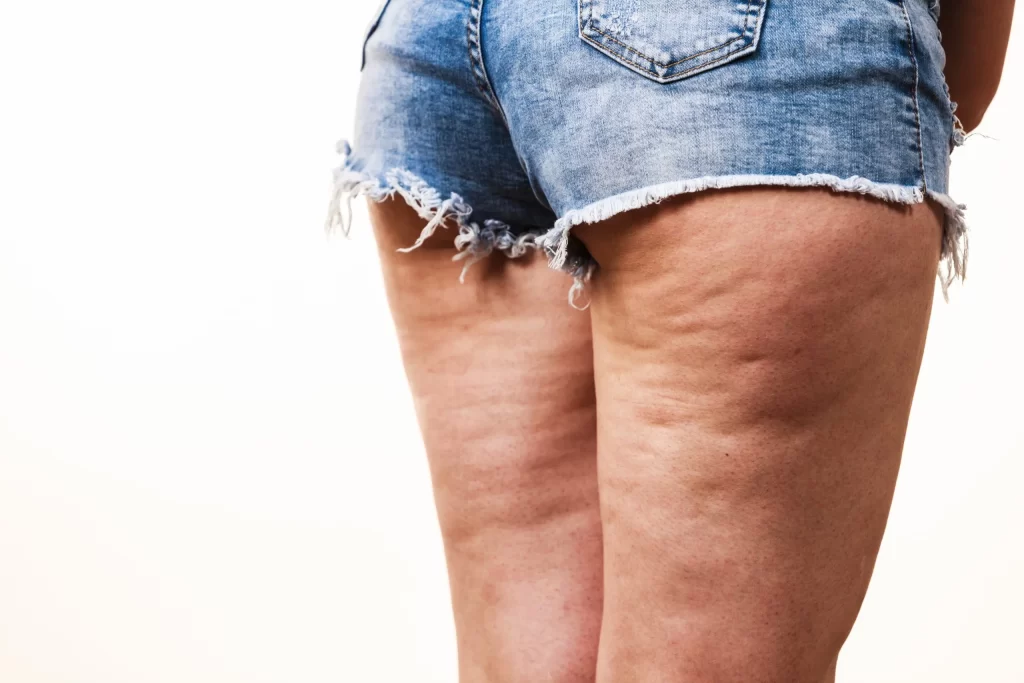Cellulite treatments for sensitive skin can be tricky. Many products irritate or worsen the condition instead of helping. However, finding the right solution is essential for smooth, healthy skin.
Natural remedies and gentle treatments can make a significant difference without causing discomfort. Options like coffee scrubs, aloe vera, and specialized creams offer relief while minimizing irritation. These approaches not only target cellulite but also cater to sensitive skin needs. Embracing these alternatives can lead to visible results and boost confidence. Say goodbye to harsh treatments that don’t deliver and hello to effective, skin-friendly solutions.
Key Takeaways
-
Consult a dermatologist before starting any cellulite treatment, especially if you have sensitive skin, to ensure safety and effectiveness.
-
Look for topical creams specifically designed for sensitive skin, as they can help minimize irritation while targeting cellulite.
-
Consider acoustic wave therapy, as it is gentle on sensitive skin and can improve skin texture and reduce the appearance of cellulite.
-
Explore laser treatment options that are suitable for sensitive skin; these can offer effective results without causing excessive discomfort.
-
Incorporate lifestyle changes, such as a balanced diet and regular exercise, to enhance the effectiveness of your cellulite treatments.
-
Steer clear of treatments that lack scientific backing or have been shown to be ineffective for cellulite reduction.
Understanding Cellulite and Sensitive Skin
What is Cellulite?
Cellulite is a common skin condition. It appears as dimpled or lumpy skin. This happens when fat deposits push through the connective tissue beneath the skin. Many people experience it, especially women. Factors like genetics, hormonal changes, and lifestyle contribute to its appearance.
Cellulite often forms on areas such as thighs, buttocks, and abdomen. The severity can vary from person to person. For some, it may be mild with only slight dimpling. Others may have more noticeable lumps and bumps. Despite being harmless, many seek treatments to reduce its visibility.
Sensitive Skin Reactions
Sensitive skin reacts differently to various products and treatments. People with sensitive skin may experience redness, irritation, or allergic reactions. This makes choosing the right treatment crucial. Normal skin might handle aggressive treatments well. However, sensitive skin requires a gentler approach.
Common triggers for sensitive skin include harsh chemicals or fragrances. These can worsen irritation and lead to discomfort. Individuals with sensitive skin should be cautious when selecting cellulite treatments. A patch test is always a good idea before applying new products.
Choosing Gentle Treatments
Selecting gentle treatments is vital for those with sensitive skin. Harsh methods can cause more harm than good. Instead of invasive procedures, consider milder options that soothe rather than irritate.
Topical creams with natural ingredients often work well. Look for products containing aloe vera or chamomile. These ingredients are known for their calming effects on the skin.
Another option is massage therapy. Gentle massages can improve circulation without causing irritation. They may also help in breaking down fat deposits that cause cellulite.
Avoid treatments that promise quick results but use strong chemicals. These often lead to negative side effects for sensitive skin types.
Consult a Dermatologist First
Professional Guidance
Seeking professional advice is crucial before starting any cellulite treatment. A dermatologist specializes in skin health. They can assess your specific situation and provide tailored recommendations. Many treatments may not suit everyone, especially those with sensitive skin.
Dermatologists understand various skin types. They consider factors such as age, genetics, and overall health. This knowledge helps them suggest the most effective options. For example, some treatments may irritate sensitive skin. Others might be too aggressive and cause further issues. Consulting a professional allows for a personalized approach.
Tailored Treatments
Each person’s skin reacts differently to treatments. Dermatologists can customize plans based on individual needs. They evaluate the severity of cellulite and skin sensitivity. This assessment ensures the chosen treatment aligns with your skin’s unique characteristics.
For instance, if you have very sensitive skin, certain procedures may be off-limits. Some treatments like laser therapy or chemical peels can be harsh. A dermatologist may recommend gentler alternatives, such as topical creams or less invasive methods.
Discussing Side Effects
Understanding potential side effects is vital, especially for sensitive skin. Every treatment carries risks that vary by individual. Dermatologists can explain these risks clearly. They can highlight which side effects are more likely for people with sensitive skin.
Patients should ask about common reactions associated with specific treatments. Redness, swelling, or irritation may occur after certain procedures. Knowing what to expect helps manage anxiety about trying new treatments.
Make sure to discuss any past reactions to skincare products during your consultation. This information provides insight into how your skin may respond to different treatments.
Importance of Follow-Up
Follow-up appointments are essential after beginning treatment. These visits allow dermatologists to monitor progress and adjust plans if necessary. Sensitive skin may react unexpectedly, requiring changes in the treatment approach.
Regular check-ins help ensure the treatment remains effective while minimizing discomfort. Patients should feel comfortable discussing their experiences during these visits.
Making Informed Decisions
Informed decisions lead to better outcomes in cellulite treatment for sensitive skin. Consulting a dermatologist provides clarity and confidence when choosing a method. Their expertise helps navigate the options available.
Patients should prioritize their well-being by seeking professional advice first. Taking this step can prevent complications and enhance results.
Topical Creams for Sensitive Skin
Testing Products
Testing creams on a small area is crucial. This method helps identify any adverse reactions before applying the product widely. Apply a small amount of cream to a discreet area, like the inner arm. Wait 24 to 48 hours to see if redness or irritation occurs. This step can save you from discomfort and skin damage.
Beneficial Ingredients
Certain ingredients may help reduce cellulite effectively. Caffeine is one such ingredient. It works by temporarily tightening the skin and improving circulation. Retinol is another valuable component. It promotes cell turnover and may improve skin texture over time. Look for creams that contain these active ingredients for better results.
Hypoallergenic Options
Selecting hypoallergenic products is essential for sensitive skin. These creams are less likely to cause allergic reactions or irritation. They often contain fewer harsh chemicals and irritants. Always read labels carefully. Avoid products with fragrances or dyes, as they can trigger sensitivities.
Consistency Matters
Using topical creams consistently yields better results. Daily application allows the active ingredients to work effectively over time. Establish a routine that fits into your skincare regimen. This commitment can lead to noticeable improvements in skin appearance.
Professional Recommendations
Consulting a dermatologist can provide tailored advice on which creams suit your skin type best. A professional can recommend specific brands or formulations that align with your needs. They can also help monitor your skin’s reaction to new products.
Lifestyle Factors
In addition to using topical treatments, consider lifestyle changes that support skin health. Staying hydrated is vital for maintaining skin elasticity. Eating a balanced diet rich in antioxidants can also promote healthier skin. Regular exercise improves circulation, which may further enhance the effectiveness of cellulite treatments.
Combining Treatments
Combining topical creams with other treatments may enhance results. Some people find success using body wraps or massages alongside their cream application. These methods can stimulate blood flow and improve the overall appearance of the skin.
Acoustic Wave Therapy Benefits
Treatment Mechanism
Acoustic wave therapy uses sound waves to target areas with cellulite. These sound waves penetrate the skin, stimulating blood flow and collagen production. The increased circulation helps break down fat deposits under the skin. This process improves the skin’s texture and reduces the appearance of cellulite.
Non-Invasive Approach
One major advantage of acoustic wave therapy is its non-invasive nature. Unlike surgical options, this treatment does not require incisions or anesthesia. It is gentle on sensitive skin, making it a suitable choice for many individuals. Patients often experience minimal discomfort during sessions.

Gradual Improvement
Results from acoustic wave therapy are not immediate. Many patients notice gradual changes over time. Typically, noticeable improvements occur after multiple sessions. Treatments usually take place once a week for several weeks. This allows the body to adjust and respond to the therapy effectively.
Safe for Sensitive Skin
Sensitive skin can react poorly to certain treatments. Acoustic wave therapy stands out because it minimizes risks associated with more invasive procedures. Patients with sensitive skin report fewer side effects compared to other methods. This makes it an appealing option for those who have struggled with harsher treatments in the past.
Long-Term Effects
The long-term benefits of acoustic wave therapy can be significant. Regular treatments may help maintain smoother skin over time. Patients often combine this therapy with other methods, such as topical creams, for enhanced results. The synergy between these treatments can lead to better outcomes in managing cellulite.
Patient Experience
Many patients describe their experience with acoustic wave therapy positively. They appreciate the comfortable environment during sessions. Most find the procedure relaxing rather than painful. Some even enjoy the feeling of warmth from the sound waves as they work on their skin.
Cost Considerations
Cost can vary based on location and provider. On average, each session may range from $100 to $300. While this might seem expensive, many consider it a worthwhile investment for effective cellulite reduction.
Laser Treatment Options
Types of Treatments
Laser treatments offer various options for reducing cellulite. Some popular methods include:
-
Cellulaze™: This treatment uses a laser to target the fibrous bands beneath the skin. It breaks down these bands, resulting in smoother skin.
-
SmoothShapes®: This method combines laser energy with light and vacuum technology. It helps to stimulate collagen production and improve skin texture.
-
VelaShape®: This treatment uses infrared light and radiofrequency energy. It heats the skin to promote circulation and reduce the appearance of cellulite.
-
UltraShape®: This non-invasive procedure uses ultrasound technology. It targets fat cells while leaving surrounding tissue unharmed.
These treatments vary in technique but share a common goal: to reduce the visibility of cellulite.
Cellulaze™ Highlights
Cellulaze™ stands out for its long-lasting results. Many patients notice improvements that last for years after just one treatment. The laser not only smooths the skin but also stimulates collagen production. This process enhances skin elasticity over time.
Studies show that patients experience significant changes in their skin’s appearance up to two years post-treatment. Cellulaze™ is FDA-approved, making it a trusted option among professionals.
Suitability for Sensitive Skin
Laser treatments can be suitable for sensitive skin types, but caution is necessary. Each person’s skin reacts differently to lasers. Some may experience redness or swelling after the procedure. Consulting with a dermatologist before undergoing any treatment is crucial.
Doctors often recommend patch tests prior to full treatments. These tests help assess how sensitive skin will react to lasers.
Patients with conditions like eczema or rosacea should discuss these issues with their provider. They might need special care or alternative treatments that are gentler on their skin.
Aftercare Considerations
Post-treatment care is essential for sensitive skin recovery. Patients should follow specific guidelines provided by their healthcare provider.
Common recommendations include:
-
Avoiding sun exposure for several weeks.
-
Using gentle moisturizers to soothe the skin.
-
Staying hydrated to support healing.
Following these steps can enhance results and reduce complications.
Radiofrequency and Ultrasound Insights
Radiofrequency Benefits
Radiofrequency (RF) treatment works by heating the deeper layers of skin. The heat targets cellulite by stimulating collagen production. This process helps to tighten the skin, which can reduce the appearance of dimples. RF treatments typically use a device that emits energy waves. These waves penetrate the skin and raise the temperature in targeted areas.
The procedure is non-invasive and usually requires multiple sessions for best results. Patients often report feeling a warm sensation during the treatment. Most find this sensation comfortable rather than painful. However, individuals with sensitive skin should consult a specialist first. They may need adjustments to avoid discomfort.
Ultrasound Functionality
Ultrasound therapy uses sound waves to break down fat deposits beneath the skin’s surface. The sound waves create vibrations that help disrupt the fat cells responsible for cellulite. This method is effective because it targets specific areas without harming surrounding tissues.
During treatment, a gel is applied to the skin. The ultrasound device glides over this gel, sending sound waves into the tissue. Many patients experience minimal discomfort during this process. Sessions typically last about 30 minutes and may require several visits for optimal results.
Sensitive Skin Considerations
Sensitive skin requires extra caution during these treatments. Both radiofrequency and ultrasound can cause irritation if not applied correctly. Practitioners must adjust settings based on individual needs. They should consider factors like skin type and sensitivity levels.
Before starting treatment, patients should discuss their concerns with professionals. A patch test may be recommended to assess how the skin reacts to these therapies. This step is crucial for preventing adverse reactions.
Aftercare is also important for sensitive skin. Patients should follow guidelines provided by their practitioners to aid recovery. Keeping the treated area moisturized can help soothe any irritation. Avoiding harsh skincare products post-treatment is also advised.
Both radiofrequency and ultrasound offer promising options for reducing cellulite. They work differently but aim for similar results: smoother, firmer skin. Patients should weigh these choices carefully, especially when dealing with sensitive skin.
Subcision Techniques Explained
Process Overview
Subcision is a minimally invasive procedure. It targets the fibrous bands under the skin. These bands pull down on the skin, causing dimpling. During subcision, a small needle is inserted into the skin. The needle breaks these fibrous bands apart. This process releases tension and improves the skin’s texture.
Patients often notice immediate improvements after the treatment. However, full results can take time to develop as the body heals.
Effectiveness in Reducing Dimpling
Subcision effectively reduces the appearance of cellulite dimpling. Studies show that many patients experience smoother skin after treatment. The procedure works well for various skin types, including sensitive skin.
One popular method is Cellfina™. This technique uses a specialized device to perform subcision. It has gained attention for its precision and effectiveness.
Patient Satisfaction Rates
High satisfaction rates characterize treatments like Cellfina™. In clinical studies, over 90% of patients reported being satisfied with their results. Many noted visible improvements in their skin’s appearance.
Patients appreciate that this treatment offers long-lasting effects. With proper care, results can last for two years or more. This durability makes it an appealing option for those seeking solutions for cellulite.
Aftercare and Longevity
Caring for the treated area is crucial for maintaining results. Patients should follow post-treatment guidelines from their healthcare provider. Keeping the skin moisturized is essential. Regular exercise and a healthy diet may also help prolong results.
e patients return for maintenance treatments as needed. These follow-up visits can help sustain the improvements achieved through subcision.
Lifestyle Changes to Support Treatment
Regular Exercise
Regular exercise helps build muscle and improve skin tone. Engaging in activities like walking, running, or swimming can boost blood circulation. This increased flow of blood delivers more nutrients to the skin. Strength training is also beneficial. It helps tone muscles, making the skin appear firmer. Aim for at least 150 minutes of moderate aerobic activity each week. Adding strength training twice a week can enhance results.
Exercise also releases endorphins. These hormones improve mood and reduce stress. Lower stress levels can lead to better skin health. People often overlook the connection between mental health and skin appearance. A positive mindset supports overall wellness, which reflects on the skin.
Balanced Diet
Maintaining a balanced diet plays a crucial role in supporting overall skin health. Eating plenty of fruits and vegetables provides essential vitamins and antioxidants. Foods rich in omega-3 fatty acids, like salmon and walnuts, help maintain skin elasticity. They can also reduce inflammation, which may worsen the appearance of cellulite.
Incorporate whole grains into daily meals. Whole grains provide fiber that aids digestion and helps eliminate toxins from the body. Reducing processed foods and sugars is equally important. These foods can cause inflammation and disrupt hormonal balance. A well-rounded diet not only supports skin health but enhances energy levels too.
Hydration
Staying hydrated is vital for enhancing skin elasticity and appearance. Drinking enough water keeps the skin plump and reduces the visibility of cellulite. Aim for at least eight glasses of water daily, or more if active. Herbal teas and water-rich fruits like watermelon also contribute to hydration.
Dehydration can lead to dry skin, making cellulite more noticeable. Proper hydration ensures that your skin remains smooth and resilient. It also aids in detoxification, helping remove waste from the body efficiently.
Stress Management
Managing stress effectively contributes to better skin health as well. High-stress levels can trigger hormonal changes that may worsen cellulite appearance. Techniques such as yoga, meditation, or deep breathing exercises can help lower stress.
Finding time for relaxation is key to maintaining a healthy lifestyle. Engaging in hobbies or spending time with loved ones can also relieve tension.
Avoid Ineffective Treatments
Questionable Methods
e treatments claim to reduce cellulite but lack scientific support. Ionithermie is one such method. It uses electrical currents and heat to target cellulite. Studies show it does not produce long-lasting effects. Many users report only temporary improvements. These results often fade quickly after treatment ends.
Temporary Solutions
Many options provide quick fixes. Creams, wraps, and spa treatments promise immediate results. However, these solutions do not address the root cause of cellulite. They may tighten skin temporarily but do not improve skin texture over time. Users may feel disappointed when results disappear shortly after treatment.
Evidence-Based Options
Focusing on evidence-based treatments can lead to better outcomes. These methods have undergone scientific testing and show real effectiveness. For example, laser therapy targets fat cells under the skin. This method can reduce the appearance of cellulite significantly. Another option is radiofrequency therapy. It heats the skin and stimulates collagen production for a smoother look.
Importance of Consistency
Consistency is key in any treatment plan. Combining evidence-based methods with lifestyle changes can enhance results. Regular exercise strengthens muscles and improves circulation. A balanced diet also plays a role in reducing body fat. Staying hydrated keeps skin healthy and plump.
Consult Professionals
Before starting any treatment, consulting a dermatologist is wise. Professionals can recommend suitable options based on individual skin types. They can help avoid ineffective treatments that may irritate sensitive skin further. Personalized advice ensures safety and efficacy.
Long-Term Commitment
Treatments for cellulite require a long-term commitment for lasting effects. Quick fixes may seem appealing, but they often lead to frustration. Evidence-based methods may take time to show results, but they are more reliable. Dedication to a consistent routine pays off in the end.
Final Remarks
Navigating cellulite treatments for sensitive skin can be tricky. You’ve explored various options, from topical creams to advanced therapies. Each treatment has its pros and cons, but the key is finding what works best for you. Always prioritize your skin’s health by consulting a dermatologist before diving into any treatment plan.
Stay informed and proactive about your skincare routine. Consider making lifestyle changes that support your treatments. Remember, effective solutions exist, and you deserve to feel confident in your skin. Take the next step today—research options, consult professionals, and start your journey toward smoother skin. Your path to feeling great starts now!
Frequently Asked Questions
What is cellulite and how does it affect sensitive skin?
Cellulite is a common skin condition characterized by dimpled, lumpy skin, often on the thighs and buttocks. Sensitive skin may react more negatively to treatments, making it essential to choose gentle options.
Why should I consult a dermatologist before starting treatment?
A dermatologist can assess your skin type and recommend suitable treatments tailored to your needs. This ensures safety and effectiveness, especially for sensitive skin.
Are there specific topical creams recommended for sensitive skin?
Yes, look for creams containing natural ingredients like caffeine or retinol. These can reduce the appearance of cellulite without irritating sensitive skin.
What are the benefits of acoustic wave therapy for cellulite?
Acoustic wave therapy uses sound waves to break down fat cells and improve circulation. It’s non-invasive and generally safe for sensitive skin, promoting smoother texture.
How do laser treatments work for cellulite?
Laser treatments target fat beneath the skin’s surface, stimulating collagen production. They can effectively reduce cellulite but should be approached cautiously with sensitive skin.
Can lifestyle changes help manage cellulite?
Absolutely! A balanced diet, regular exercise, and hydration can enhance skin elasticity and overall appearance. These changes support any treatment plan you choose.
What treatments should I avoid if I have sensitive skin?
Avoid aggressive procedures like deep chemical peels or intense laser treatments. These can exacerbate sensitivity and lead to adverse reactions. Always opt for gentler alternatives.





